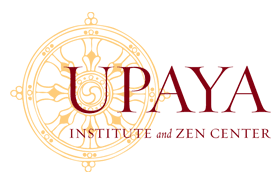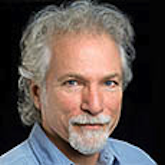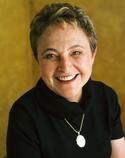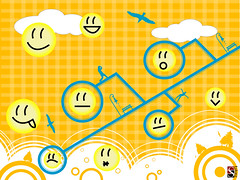
From the most recent issue of the APA's Monitor on Psychology, "time capsule" tribute to the woman who got homosexuality delisted as a mental illness and removed from the Diagnostic and Statistical Manual III of the American Psychiatric Association.
The myth buster
Evelyn Hooker’s groundbreaking research exploded the notion that homosexuality was a mental illness, ultimately removing it from the DSM.
By Katharine S. Milar
February 2011, Vol 42, No. 2
Print version: page 24
In 1953, Evelyn Hooker, PhD, applied for a National Institute of Mental Health (NIMH) grant to conduct research on “normal homosexuals.” During this period of American history, Sen. Joseph McCarthy was seeking out communists wherever he suspected they might be lurking; homosexual acts were a crime; bomb shelters were springing up in backyards; and the term “normal” homosexual was thought to be an oxymoron. A variety of medical and psychological treatments to “cure” homosexuality were employed, including ice pick lobotomies, electroshock, chemical castration with hormonal treatment or aversive conditioning. Gay parties were raided by the police, particularly in election years when a crackdown on “sexual perversion” was seen as a positive step in the fight on crime.
Hooker’s proposal to study gay men began as a result of a close friendship she developed with a former University of California, Los Angeles, student, Sam From, who introduced her to the gay subculture. She became one of the heterosexuals “in the know.” It was From who told her it was her “scientific duty” to study homosexuals and promised her access to all the subjects she needed. Initially she demurred but eventually, with the encouragement of From and her colleague Bruno Klopfer, Hooker began an investigation that would ultimately result in the removal of homosexuality as a form of psychopathology from the Diagnostic and Statistical Manual III of the American Psychiatric Association. This research was the culmination of Hooker’s lifelong interest in social justice.Humble beginnings
Evelyn Hooker was born Evelyn Gentry Sept. 2, 1907 in North Platte, Neb., the sixth of nine children. Photos of her as a school child show that she towered above most of her classmates; she was nearly 6 feet tall as an adult. Her family was quite poor, and neither parent was educated past fourth grade. Her adolescence was colored by these social stigmata; she attributed her study of “an oppressed, deprived people,” (homosexual men) to her early experience (Garnets & Kimmel, 2003, p. 36). After earning her bachelor’s and master’s degrees at the University of Colorado with Karl Muenzinger, she aspired to earn a doctorate at Yale, but the department chair at Colorado refused to recommend a woman to his alma mater. Instead, she completed her doctorate in experimental psychology at Johns Hopkins University in 1932, studying vicarious trial-and-error learning in rats. A fellowship in 1937–38 took her to Berlin to pursue her increasing interest in clinical psychology at the Institute for Psychotherapy. She lived with a Jewish family and witnessed, with dismay, Hitler’s rise to power. Much later, after her return to the United States, she learned that all members of her host family perished in the concentration camps.
A trip to the Soviet Union at the end of her fellowship year exposed her to another totalitarian regime and caused problems for her after she returned to a tenure track position at Whittier College, in Whittier, Calif. Suspected of holding subversive political views, she lost her position. She appealed to her graduate mentor at Johns Hopkins, Knight Dunlap, who was then chair of the department at UCLA, but he could only offer her a research associate position in the psychology department, telling Hooker that the three women in the department were “cordially disliked” and he could not appoint another woman. She was instead appointed to the UCLA Extension division, and it was here that she met Sam From as a student in her introductory psychology course.
Stimulated by her experience with various forms of discrimination and her friendship with From, Hooker began interviewing gay men who were friends or friends of friends. In the middle of her investigations, her husband, Donn Caldwell, an alcoholic, divorced her, saying he didn’t want to destroy her as he was destroying himself. In emotional turmoil, Hooker left her research and California for a time. In 1948, she returned to her job at UCLA and rented a small house from a distinguished professor of English Edward Niles Hooker. They married in 1951.
Back in California, now happily married and without heavy teaching commitments, Evelyn Hooker returned to her research on gay men. She decided that her previous interviews were not useful; they had not been planned carefully enough. So, she decided to apply for a grant from NIMH. The chief of the grants division, John Eberhart, flew out to interview her to see who this woman was who claimed she had access to any number of gay men who were neither psychiatric patients nor prisoners. He told her, given the climate of McCarthyism, everyone was being investigated and if she got the grant, “you won’t know why and we won’t know why” (1993, p. 450). (Eberhart later told Hooker that her project was derisively referred to as “The Fairy Project” by some federal officials in Washington.) Funding was granted and Hooker embarked on her study.
She recruited 30 exclusively homosexual and 30 exclusively heterosexual men, matched for age, IQ scores and education. With the aid of the Mattachine Society, one of the first gay-rights organizations, access to homosexuals was no problem, but finding heterosexual men who would agree to participate was very difficult. She could not conduct the study on the UCLA campus in spite of pressure to do so. The nature of the research required strict confidentiality, so she used a small study on her spacious Los Angeles estate on Saltair Avenue. She approached firemen, policemen, maintenance workers, any heterosexual men she could persuade to participate. Her husband said, “No man is safe on Saltair Avenue.”
Each participant took three projective tests: The Rorschach, the Make a Picture Story Test (MAPS) and the Thematic Apperception Test (TAT). After scoring the tests herself, she then gave the test protocols with all identifying information removed to experts in those tests: Bruno Klopfer for the Rorschach, Edward Shneidman, the inventor of MAPS, and Mortimer Meyer for the TAT. An adjustment rating was assigned to each participant based on the test scores, and then the experts were given paired Rorschach protocols, one from a gay participant, one from a straight participant and asked to identify the homosexual. As with heterosexuals, homosexuals’ adjustment varied from superior to disturbed. Two-thirds of the research participants in each group were judged as having average or better adjustment. Further, experts were unable to identify the gay participant’s protocol from the matched pairs at better than chance accuracy. There was no association between homosexuality and psychological maladjustment. One of her experts, who was sure he could distinguish the groups, asked for another chance to review the protocols, but was no more successful the second time than the first.
Hooker reported that one of the most exciting days of her life was the day she presented the results of her research at APA’s 1956 Annual Convention in Chicago. This ground-breaking research and the work that followed on the homosexual subculture led to Hooker’s award in 1992 for Distinguished Contribution to Psychology in the Public Interest from APA. In her response to this honor, she shared the award with the gay and lesbian community and expressed pleasure that her research and her “long advocacy of a scientific view of homosexuality” could make their lives and the lives of their families better. She closed her address by reading from a letter she had received from a gay man thanking her for her work and saying, “I think you did it because you knew what love was when you saw it, and you knew that gay love was like all other love.”
~ Katharine S. Milar, PhD, is a professor of psychology at Earlham College and historical editor for “Time Capsule.”
Article Sidebar
Hooker’s legacy continues
Suggested reading
- Garnets, L.D., & Kimmel, D. (2003). What a light it shed: The life of Evelyn Hooker. In L.D. Garnets & D.C. Kimmel (Eds.) Perspectives on gay, lesbian and bisexual experiences (pp. 31–49). New York: Columbia University Press.
- Harrison, J. (Producer), & Schmiechen, R. (Director). (1991). Changing Our Minds, The Story of Dr. Evelyn Hooker. [film]. Distributed by Frameline. http://www.frameline.org
- Hooker, E. (1993). Reflections of a 40-year exploration: A scientific view on homosexuality. American Psychologist, 48, 450–453.
- Minton, H.L. (2002). Departing from deviance: A history of homosexual rights and emancipatory science in America. Chicago, IL: University of Chicago Press.
- Shneidman, E.S. (1998). Evelyn Hooker (1907–1996). [Obituary]. American Psychologist, 53, 480–481.













